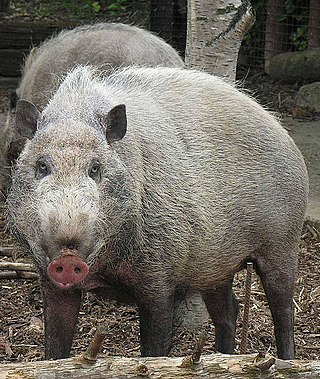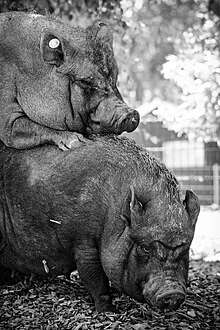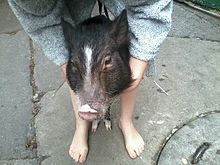
Sus is the genus of wild and domestic pigs, within the even-toed ungulate family Suidae. Sus include domestic pigs and their ancestor, the common Eurasian wild boar, along with other species. Sus species, like all suids, are native to the Eurasian and African continents, ranging from Europe to the Pacific islands. Suids other than the pig are the babirusa of Indonesia, the pygmy hog of South Asia, the warthogs of Africa, and other pig genera from Africa. The suids are a sister clade to peccaries.

Intensive pig farming, also known as pig factory farming, is the primary method of pig production, in which grower pigs are housed indoors in group-housing or straw-lined sheds, whilst pregnant sows are housed in gestation crates or pens and give birth in farrowing crates.

Disembowelment, disemboweling, evisceration, eviscerating or gutting is the removal of organs from the gastrointestinal tract, usually through an incision made across the abdominal area. Disembowelment is a standard routine operation during animal slaughter. In ancient Rome, disembowelment of animals was practiced for divination, and was known as haruspicy. Disembowelment of humans may result from an accident, but has also been used as a method of torture, execution, or suicide. In such practices, disembowelment may be accompanied by various forms of torture or the removal of other vital organs.

Pig racing is a sport in which juvenile pigs race around in a small, enclosed area of either dirt, fake grass, gravel track or steel-framed enclosures. This racing is usually purely for entertainment or charity, and betting is rarely part of it, as the races are family-friendly events.

Xenotransplantation, or heterologous transplant, is the transplantation of living cells, tissues or organs from one species to another. Such cells, tissues or organs are called xenografts or xenotransplants. It is contrasted with allotransplantation, syngeneic transplantation or isotransplantation and autotransplantation. Xenotransplantation is an artificial method of creating an animal-human chimera, that is, a human with a subset of animal cells. In contrast, an individual where each cell contains genetic material from a human and an animal is called a human–animal hybrid.

In drug development, preclinical development is a stage of research that begins before clinical trials and during which important feasibility, iterative testing and drug safety data are collected, typically in laboratory animals.

The pig, also called swine or hog, is an omnivorous, domesticated, even-toed, hoofed mammal. It is named the domestic pig when distinguishing it from other members of the genus Sus. It is considered a subspecies of Sus scrofa by some authorities, but as a distinct species by others. Pigs were domesticated in the Neolithic, both in East Asia and in the Near East. When domesticated pigs arrived in Europe, they extensively interbred with wild boar but retained their domesticated features.

Pigs, widespread in societies around the world since neolithic times, have been used for many purposes in art, literature, and other expressions of human culture. In classical times, the Romans considered pork the finest of meats, enjoying sausages, and depicting them in their art. Across Europe, pigs have been celebrated in carnivals since the Middle Ages, becoming specially important in Medieval Germany in cities such as Nuremberg, and in Early Modern Italy in cities such as Bologna.

The history of animal testing goes back to the writings of the Ancient Greeks in the 4th and 3rd centuries BCE, with Aristotle and Erasistratus one of the first documented to perform experiments on nonhuman animals. Galen, a physician in 2nd-century Rome, dissected pigs and goats, and is known as the "Father of Vivisection." Avenzoar, an Arabic physician in 12th-century Moorish Spain who also practiced dissection, introduced animal testing as an experimental method of testing surgical procedures before applying them to human patients. Although the exact purpose of the procedure was unclear, a Neolithic surgeon performed trepanation on a cow in 3400-3000 BCE. This is the earliest known surgery to have been performed on an animal, and it is possible that the procedure was done on a dead cow in order for the surgeon to practice their skills.

The Livestock Conservancy, formerly known as the American Livestock Breeds Conservancy (ALBC) and prior to that, the American Minor Breeds Conservancy, is a nonprofit organization focused on preserving and promoting rare breeds, also known as "heritage breeds" of livestock. Founded in 1977, through the efforts of livestock breed enthusiasts concerned about the disappearance of many of the US's heritage livestock breeds, The Livestock Conservancy was the pioneer livestock preservation organization in the United States, and remains a leading organization in that field. It has initiated programs that have saved multiple breeds from extinction, and works closely with similar organizations in other countries, including Rare Breeds Canada. With 3,000 members, a staff of eleven and a 19-member board of directors, the organization has an operating budget of over a million dollars.

A dwarf cat is a domestic cat with dwarfism due to rare genetic mutations causing a disproportionate feline body and significant health problems. Unlike undersized cats of normal proportions, dwarf cats suffer from the genetic mutations osteochondrodysplasia and achondroplasia. These genetic disorders of bone and cartilage are typically manifested as abnormal bone shape, poor growth or lack of growth, bowing of the limbs to the side – front legs are more likely to be affected, and spinal malformations.

Pig farming, pork farming, or hog farming is the raising and breeding of domestic pigs as livestock, and is a branch of animal husbandry. Pigs are farmed principally for food and skins.

The Mangalica is a Hungarian breed of domestic pig. It was developed in the mid-19th century by crossbreeding breeds from the nearby Romanian Salonta and Hungarian Bakony with the European wild boar and the Serbian Šumadija breed. The Mangalica pig grows a thick, curly coat of hair. The only other pig breed noted for having a long coat is the extinct Lincolnshire Curly Coat pig of England.
National Pig Day is an event held annually on the first day of March in the United States to celebrate the pig. The holiday is most often celebrated in the Midwest of the US. It is not a federal holiday.

Genetically modified mammals are mammals that have been genetically engineered. They are an important category of genetically modified organisms. The majority of research involving genetically modified mammals involves mice with attempts to produce knockout animals in other mammalian species limited by the inability to derive and stably culture embryonic stem cells.

The Göttingen minipig is a breed of miniature pig. The Göttingen minipig is the smallest domestic pig breed known in the world; as an adult, they weigh around 35 kg (77 lb). Beside being known for their exceptionally small size, the Göttingen minipigs are known for their docile nature and very clean and well-characterized health status. Raising of this breed began in the late 1960s at the Institute of Animal Breeding and Genetics at the University of Göttingen, Germany, by crossbreeding the Minnesota mini-pig, the Vietnamese Pot-bellied pig, and the German Landrace pig. Göttingen minipigs are highly favored as pets, however, the breed was specifically developed for biomedical research. Today, they are extensively bred at four separate locations globally.
Thunder and Bolt are a pair of miniature pigs certified by the American Mini Pig Association as therapy animals owned and trained by then 10-year-old Claire Barrow.


















